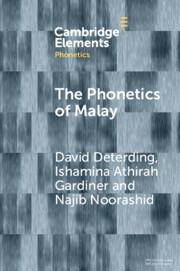Refine search
Actions for selected content:
36 results
Regional variation in English in British Columbia
-
- Journal:
- Journal of Linguistic Geography / Volume 13 / Issue 1 / April 2025
- Published online by Cambridge University Press:
- 27 August 2025, pp. 2-32
-
- Article
-
- You have access
- Open access
- HTML
- Export citation
6 - Acquisition of Welsh Phonology
- from Part II - Acquisition of Phonology and Phonetics
-
-
- Book:
- The Acquisition of Celtic Languages
- Published online:
- 03 July 2025
- Print publication:
- 10 July 2025, pp 109-130
-
- Chapter
- Export citation
5 - Phonology
-
- Book:
- The Balkan Languages
- Published online:
- 31 May 2025
- Print publication:
- 26 June 2025, pp 359-494
-
- Chapter
-
- You have access
- Open access
- HTML
- Export citation
2 - The Sounds of German
- from Part I - Lower Prosodic Constituents: Moras, Syllables, Feet
-
- Book:
- German Phonology
- Published online:
- 04 January 2025
- Print publication:
- 09 January 2025, pp 27-76
-
- Chapter
- Export citation
22 - The Phonetics and Phonology of Early Bilinguals
- from Part V - The Diversity of Bilingual Speakers
-
-
- Book:
- The Cambridge Handbook of Bilingual Phonetics and Phonology
- Published online:
- 14 November 2024
- Print publication:
- 21 November 2024, pp 501-520
-
- Chapter
- Export citation
20 - Acquisition of Segmental Phonology in Adult Bilingualism
- from Part IV - The Phonetics and Phonology of the Bilingual Adult
-
-
- Book:
- The Cambridge Handbook of Bilingual Phonetics and Phonology
- Published online:
- 14 November 2024
- Print publication:
- 21 November 2024, pp 448-470
-
- Chapter
- Export citation
26 - The Phonetics and Phonology of Indigenous Language Bilinguals
- from Part V - The Diversity of Bilingual Speakers
-
-
- Book:
- The Cambridge Handbook of Bilingual Phonetics and Phonology
- Published online:
- 14 November 2024
- Print publication:
- 21 November 2024, pp 584-606
-
- Chapter
- Export citation
9 - Insular Varieties of English in Britain
- from Part I - English
-
-
- Book:
- Language in Britain and Ireland
- Published online:
- 17 October 2024
- Print publication:
- 31 October 2024, pp 249-257
-
- Chapter
- Export citation
3 - Phonetic and Phonological Variation in England
- from Part I - English
-
-
- Book:
- Language in Britain and Ireland
- Published online:
- 17 October 2024
- Print publication:
- 31 October 2024, pp 70-97
-
- Chapter
- Export citation
Methodological issues in Rma etymology
-
- Journal:
- Bulletin of the School of Oriental and African Studies / Volume 87 / Issue 2 / June 2024
- Published online by Cambridge University Press:
- 04 June 2024, pp. 357-374
- Print publication:
- June 2024
-
- Article
- Export citation
Classification of English vowels in terms of Cypriot Greek categories: The role of acoustic similarity between L1 and L2 sounds
-
- Journal:
- Canadian Journal of Linguistics/Revue canadienne de linguistique / Volume 69 / Issue 1 / March 2024
- Published online by Cambridge University Press:
- 27 February 2024, pp. 46-62
-
- Article
-
- You have access
- Open access
- HTML
- Export citation
3 - The Vowels of English
-
- Book:
- The Sounds of English Around the World
- Published online:
- 25 August 2023
- Print publication:
- 14 September 2023, pp 45-118
-
- Chapter
- Export citation
19 - Being a Good Partner
-
- Book:
- How to Talk Language Science with Everybody
- Published online:
- 17 May 2023
- Print publication:
- 29 June 2023, pp 231-241
-
- Chapter
- Export citation
Chapter 2 - Segmental Phonology
-
- Book:
- The Lexical and Metrical Phonology of English
- Published online:
- 18 June 2022
- Print publication:
- 26 May 2022, pp 52-78
-
- Chapter
- Export citation

The Phonetics of Malay
-
- Published online:
- 03 February 2022
- Print publication:
- 19 May 2022
-
- Element
- Export citation
4 - Sex Differences in General North American English
-
- Book:
- Accent in North American Film and Television
- Published online:
- 16 December 2021
- Print publication:
- 16 December 2021, pp 165-179
-
- Chapter
- Export citation
3 - The Emergence of General North American English
-
- Book:
- Accent in North American Film and Television
- Published online:
- 16 December 2021
- Print publication:
- 16 December 2021, pp 109-164
-
- Chapter
- Export citation
7 - Ethnic Accents in North American Film and Television
-
- Book:
- Accent in North American Film and Television
- Published online:
- 16 December 2021
- Print publication:
- 16 December 2021, pp 252-294
-
- Chapter
- Export citation
6 - Other Regional Accents in North American Film and Television
-
- Book:
- Accent in North American Film and Television
- Published online:
- 16 December 2021
- Print publication:
- 16 December 2021, pp 205-251
-
- Chapter
- Export citation
2 - Method
-
- Book:
- Accent in North American Film and Television
- Published online:
- 16 December 2021
- Print publication:
- 16 December 2021, pp 58-108
-
- Chapter
- Export citation
